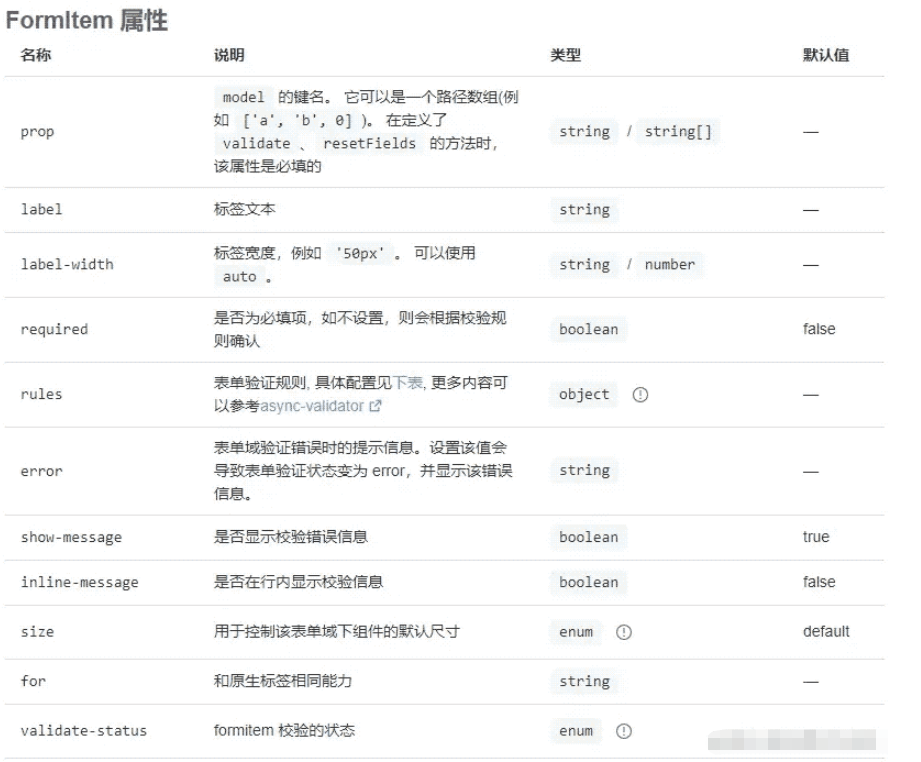您好,登錄后才能下訂單哦!
您好,登錄后才能下訂單哦!
這篇“vue如何封裝一個高質量的表單通用組件”文章的知識點大部分人都不太理解,所以小編給大家總結了以下內容,內容詳細,步驟清晰,具有一定的借鑒價值,希望大家閱讀完這篇文章能有所收獲,下面我們一起來看看這篇“vue如何封裝一個高質量的表單通用組件”文章吧。
特性復用:必須繼承原有組件的所有特性。
命名規范:二次組件名必須見名知意,我們一般都是起一個公用名+原有組件名,比如lib-form。
接口簡單:自定義暴露出來的接口越簡單越好。
容易拓展:留有自定義插槽,讓用戶可以自己選擇。
功能完善:具備更完善的功能如:表單驗證、動態刪減表單,集成第三方的插件(富文本)...
場景通用:具備多個場景使用,比如彈框嵌套表單、頁面嵌套表單。
封裝一個高質量的通用組件,上面是真的只是基操,話不多說,直接上實踐手把手教你封裝組件。
繼承原有組件的所有特性(這也是封裝的核心)。先明確三個大方向:
表單固定屬性,繼承Form表單的所有屬性、方法。
// 定義el-form的ref繼承原有組件的form屬性
export interface FormInstance {
registerLabelWidth(width: number, oldWidth: number): void,
deregisterLabelWidth(width: number): void,
autoLabelWidth: string | undefined,
emit: (evt: string, ...args: any[]) => void,
labelSuffix: string,
inline?: boolean,
model?: Record<string, unknown>,
size?: string,
showMessage?: boolean,
labelPosition?: string,
labelWidth?: string,
rules?: Record<string, unknown>,
statusIcon?: boolean,
hideRequiredAsterisk?: boolean,
disabled?: boolean,
validate: (callback?: Callback) => Promise<boolean>,
resetFields: () => void,
clearValidate: (props?: string | string[]) => void,
validateField: (props: string | string[], cb: ValidateFieldCallback) => void,
}表單項固定屬性,繼承表單項的所有屬性、方法。
// 表單每一項的配置選項
export interface FormOptions {
// 表單項顯示的元素
type: '',// 定義表單項類型
value?: any, // 表單項的值
label?: string,// 表單項label
prop?: string,// 表單項的標識
rules?: RuleItem[],// 表單項的驗證規則
placeholder?: string,// 表單項的占位符
attrs?: { // 按需定義不同表單類型屬性
...
},
children?: FormOptions[],// 表單項的子元素,可能存在嵌套表單組件,如select
....// 適當擴展我們需要的屬性,比如上傳組件屬性,行布局表單屬性
}由于Element-plus組件都是以el-為前綴,所以type取值只需要取el-后面部分作為值就行,比如el-input取 'input' 為值。

表單驗證效果,繼承組件原有的所有驗證屬性。由于Element-plus的驗證都是使用 async-validator 這個插件的驗證方法,直接復用插件源碼路徑async-validator/src/interface.ts文件下的所有代碼:
// 核心代碼:封裝驗證方式時的屬性
export interface RuleItem {
type?: RuleType; // 驗證種類
required?: boolean;// 是否必填
pattern?: RegExp | string;// 驗證方式匹配
min?: number; // 表單項最小值
max?: number; // 表單項最大值
len?: number; // 表單項字符長度
trigger?: string | string[];// 驗證觸發方式
....
}實現一個完善的通用組件封裝,通過對標簽封裝、接口 暴露、開發者傳參等。明確表單類型,根據不同類型表單復用多種場景,不僅開發者用戶拓展,而且,讓開發者用最少代碼就可以復用:
<!--表單框架:model就是傳入的表單對象,rules就是傳入的驗證對象 --> <el-form v-if="model" :validate-on-rule-change="false" v-bind="$attrs" :model="model" :rules="rules" ref="form" > ... <!--表單項封裝 --> </el-form>
普通表單項封裝,比如日期、輸入等組件。
<template v-for="(item, index) in options" :key="index">
<el-form-item :label="item.label" :prop="item.prop">
<component
v-else
:is="`el-${item.type}`"
v-bind="item.attrs"
v-model="model[item?.prop!]"
>
</component>
</el-form-item>
</template>嵌套表單項封裝,比如下拉框,除了select組件還嵌套option組件。
<template v-for="(item, index) in options" :key="index">
<el-form-item
v-if="item.children && item.children.length"
:label="item.label"
:prop="item.prop"
>
<component
:is="`el-${item.type}`"
v-bind="item.attrs"
v-model="model[item?.prop!]"
>
<component
v-for="(child, i) in item.children"
:key="i"
:label="child.label"
:value="child.value"
:is="`el-${child.type}`"
>
</component>
</component>
</el-form-item>
</template>本文使用的是wangEditor。
<div id="editor" v-else-if="item.type === 'editor'"></div>
import E from 'wangeditor';
// 遍歷傳入的prop的options對象,初始化富文本
if (item.type === 'editor') {
// 初始化富文本
nextTick(() => {
if (document.getElementById('editor')) {
const editor = new E('#editor');
editor.config.placeholder = item.placeholder!;
editor.create();
// 初始化富文本的內容
editor.txt.html(item.value);
editor.config.onchange = (newHtml: string) => {
model.value[item.prop!] = newHtml;
};
edit.value = editor;
}
});
}向開發者暴露上傳的核心方法:預覽、刪除、上傳成功等,同時允許開發者自定義上傳信息以及渲染區域等。
<el-form-item :label="item.label" :prop="item.prop"> <!-- 上傳表單 --> <el-upload v-if="item.type === 'upload'" v-bind="item.uploadAttrs" :on-preview="onPreview" :on-remove="onRemove" :on-success="onSuccess" :on-error="onError" :on-progress="onProgress" :on-change="onChange" :before-upload="beforeUpload" :before-remove="beforeRemove" :http-request="httpRequest" > <slot name="uploadArea"></slot> <slot name="uploadTip"></slot> </el-upload> </el-form-item>
有時業務需要,一行可以定義多個表單,所以需要使用el-row,此時需要修改FormOptions屬性接口,完善多個表單場景,cols是一個數組定義FormOptions數組,colOption是el-col組件的相關屬性,然后重新復用嵌套表單的代碼。
<template v-if="item.type === 'row'">
<el-row :gutter="item.rowGutter">
<el-col
v-for="(jtem, jndex) in item.cols"
v-bind="jtem.colOption"
:key="jndex"
>
<el-form-item :label="jtem.label" :prop="jtem.prop">
<component
:is="`el-${jtem.type}`"
v-bind="jtem.attrs"
v-model="model[jtem?.prop!]"
>
<template v-if="jtem.children && jtem.children.length">
<component
v-for="(child, i) in jtem.children"
:key="i"
:label="child.label"
:value="child.value"
:is="`el-${child.type}`"
>
</component>
</template>
</component>
</el-form-item>
</el-col>
</el-row>
</template>自定義插槽:開發者可以根據需要,在封裝的el-form中添加插槽,可以允許組件功能的拓展,我們可以根據自己需要進行封裝,這里就不一一演示了。
提交取消按鈕區域:這個最好可以實現插槽讓開發者可以自定義。
<el-form-item> <slot name="action" :form="form" :model="model"></slot> </el-form-item>
開發者的調用封裝組件,通過配置不同表單類型的數組,然后調用lib-form封裝組件實現業務代碼復用。
組件的調用:根據業務需要,可以適當定義我們需要的組件屬性以及必須要傳的參數。
<lib-form ref="form" label-width="100px" :options="options" @on-change="handleChange" @before-upload="handleBeforeUpload" @on-preview="handlePreview" @on-remove="handleRemove" @before-remove="beforeRemove" @on-success="handleSuccess" @on-exceed="handleExceed" > <template #uploadArea> <el-button size="small" type="primary">Click to upload</el-button> </template> <template #uploadTip> <div > jpg/png files with a size less than 500kb </div> </template> <template #action="scope"> <el-button type="primary" @click="submitForm(scope)">提交</el-button> <el-button @click="resetForm">重置</el-button> </template> </lib-form>
表單項的配置數組:由于這配置數組比較長,所以一般可以單獨抽離出來,不要寫在vue文件中,這樣可以提高代碼的可讀性。
// 這里以多行表單布局為例子
let options: FormOptions[] = [
{
type: 'row',
rowGutter: 20,
cols: [
{
type: 'input',
value: '',
label: '用戶名',
prop: 'username',
placeholder: '請輸入用戶名',
rules: [
{
required: true,
message: '用戶名不能為空',
trigger: 'blur',
},
{
min: 2,
max: 6,
message: '用戶名在2-6位之間',
trigger: 'blur',
},
],
attrs: {
clearable: true,
},
colOption: {
offset: 0,
span: 12,
},
},
{
type: 'input',
value: '',
label: '用戶名',
prop: 'username',
placeholder: '請輸入用戶名',
rules: [
{
required: true,
message: '用戶名不能為空',
trigger: 'blur',
},
{
min: 2,
max: 6,
message: '用戶名在2-6位之間',
trigger: 'blur',
},
],
attrs: {
clearable: true,
},
colOption: {
offset: 0,
span: 12,
},
},
],
},
]以上就是關于“vue如何封裝一個高質量的表單通用組件”這篇文章的內容,相信大家都有了一定的了解,希望小編分享的內容對大家有幫助,若想了解更多相關的知識內容,請關注億速云行業資訊頻道。
免責聲明:本站發布的內容(圖片、視頻和文字)以原創、轉載和分享為主,文章觀點不代表本網站立場,如果涉及侵權請聯系站長郵箱:is@yisu.com進行舉報,并提供相關證據,一經查實,將立刻刪除涉嫌侵權內容。